
Erica arborea, the tree heath or tree heather, is a species of flowering plant (angiosperms) in the heather family Ericaceae, native to the Mediterranean Basin and Ethiopia, Kenya and Tanzania in East Africa. It is also cultivated as an ornamental.

Carpenteria, the tree anemone or bush anemone, is a genus of flowering plants in the hydrangea family Hydrangeaceae. It is closely related to the similar genus Philadelphus and is monotypic, being represented by the single species Carpenteria californica which is a flowering evergreen shrub native to the Sierra Nevada foothills in California.

Delphinium is a genus of about 300 species of annual and perennial flowering plants in the family Ranunculaceae, native throughout the Northern Hemisphere and also on the high mountains of tropical Africa. The genus was erected by Carl Linnaeus.

Sorbus is a genus of over 100 species of trees and shrubs in the rose family, Rosaceae. Species of Sorbus (s.l.) are commonly known as whitebeam, rowan, mountain-ash and service tree. The exact number of species is disputed depending on the circumscription of the genus, and also due to the number of apomictic microspecies, which some treat as distinct species, but others group in a smaller number of variable species. Recent treatments classify Sorbus in a narrower sense to include only the pinnate leaved species of subgenus Sorbus, raising several of the other subgenera to generic rank.
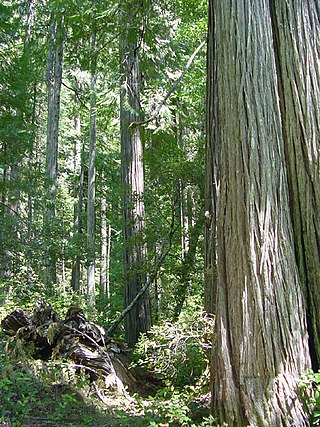
Chamaecyparis lawsoniana, known as Port Orford cedar or Lawson cypress, is a species of conifer in the genus Chamaecyparis, family Cupressaceae. It is native to Oregon and northwestern California, and grows from sea level up to 4,900 feet (1,500 m) in the valleys of the Klamath Mountains, often along streams.

Pulmonaria (lungwort) is a genus of flowering plants in the family Boraginaceae, native to Europe and western Asia, with one species east to central Asia. According to various estimates there may be between 10 and 18 species found in the wild.
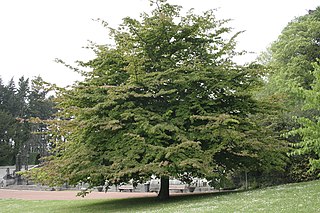
Parrotia persica, the Persian ironwood, is a deciduous tree in the family Hamamelidaceae, closely related to the witch-hazel genus Hamamelis. It is native to Iran's Caspian region and Azerbaijan. It is endemic in the Alborz mountains, where it is found mainly in Golestan National Park.

Viburnum tinus, the laurustinus, laurustine or laurestine, is a species of flowering plant in the family Adoxaceae, native to the Mediterranean area of Europe and North Africa. Laurus signifies the leaves' similarities to bay laurel.
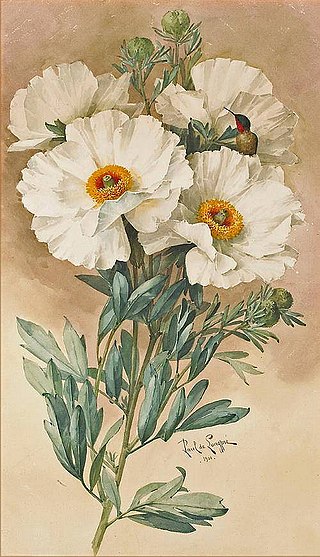
Romneya coulteri, the Coulter's Matilija poppy or California tree poppy, is a perennial species of flowering plant in the poppy family Papaveraceae. Native to southern California, USA, and Baja California, Mexico, it grows in dry canyons in chaparral and coastal sage scrub plant communities, sometimes in areas recently burned. It is a popular ornamental plant, kept for its large, showy flowers.

Hunnemannia is a monotypic genus of flowering plants in the poppy family Papaveraceae, containing the single species Hunnemannia fumariifolia native to the highlands of Mexico. It is typically found at elevations of 1,500–2,000 m (4,921–6,562 ft) in the Chihuahuan Desert and south into central Mexico, where it favors rocky habitats, occurring along roadsides as well.
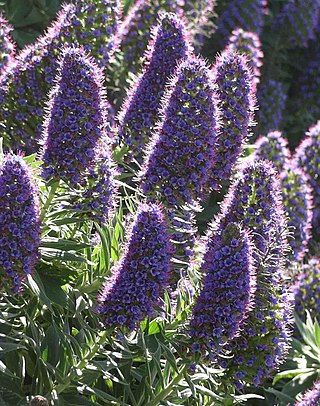
Echium candicans, the 'Pride of Madeira', is a species of flowering plant in the family Boraginaceae, and genus Echium, native to the island of Madeira. It is a large herbaceous perennial subshrub, growing to 1.5–2.5 m.

Stewartia malacodendron, the silky camellia, silky stewartia or Virginia stewartia, is a species of flowering plant in the family Theaceae. It grows slowly into a large deciduous shrub or small tree, typically 3–4.5 m (10–15 ft) tall, but sometimes as tall as 9 m (30 ft). It is native to the southeastern United States.
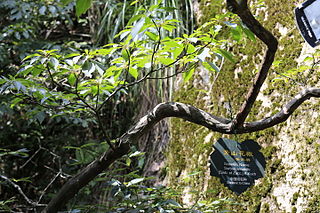
Sorbus commixta, the Japanese rowan, is a species of flowering plant in the family Rosaceae, native to central and eastern China, Korea, Japan, and Sakhalin.

Deutzia gracilis, the slender deutzia or Japanese snow flower, is a species of flowering plant in the hydrangea family Hydrangeaceae, native to Japan.
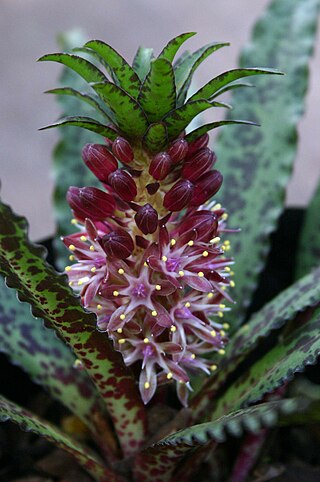
Eucomis vandermerwei is a South African bulbous perennial flowering plant, a member of the asparagus family, and like other members of Eucomis is commonly known as pineapple lily for its superficial resemblance to that plant, although not closely related to it. This species is one of the smallest in the genus, and is native to a high-rainfall region of western Mpumalanga in South Africa. The dense rosette of leaves, either prostrate or ascending, is heavily blotched with purple, and the leaf-edges are markedly crisped or wavy. The star-shaped burgundy flowers appear in midsummer, and are borne on a spike (raceme) topped by a "head" of leafy bracts.

Acer palmatum, commonly known as Japanese maple, palmate maple, or smooth Japanese maple (Korean: danpungnamu, 단풍나무, Japanese: irohamomiji, イロハモミジ, or momiji,, is a species of woody plant native to Korea, Japan, China, eastern Mongolia, and southeast Russia. Many different cultivars of this maple have been selected and they are grown worldwide for their large variety of attractive forms, leaf shapes, and spectacular colors.

Eucryphia glutinosa, the brush bush or nirrhe, is a species of flowering plant in the family Cunoniaceae, native to moist woodland habitats in Chile. It is a large deciduous shrub or small tree, growing to 10 m (33 ft) tall by 6 m (20 ft) wide, with glossy dark green leaves turning red in autumn. Single four-petalled, fragrant white flowers with prominent stamens appear in late summer.

Tamarix tetrandra is a species of flowering plant in the family Tamaricaceae, native to south eastern Europe, Turkey, Bulgaria and Crimea. Growing to 3 m (10 ft) tall and broad, it is a small deciduous tree with almost black arching branches, and tiny scale-like leaves arranged along the branches. Racemes of pale pink flowers are produced in late spring.

Pleroma urvilleanum, synonym Tibouchina urvilleana, is a species of flowering plant in the family Melastomataceae, native to Brazil.

Melaleuca salicina, commonly known as willow bottlebrush, is a plant in the myrtle family Myrtaceae, and is endemic to eastern Australia. Some Australian state herbaria continue to use the name Callistemon salignus, a name that is accepted by the Australian Plant Census. It is a shrub or small tree with soft foliage, pink new growth, white papery bark and spikes of usually white or creamy bottlebrush flowers in spring.





















